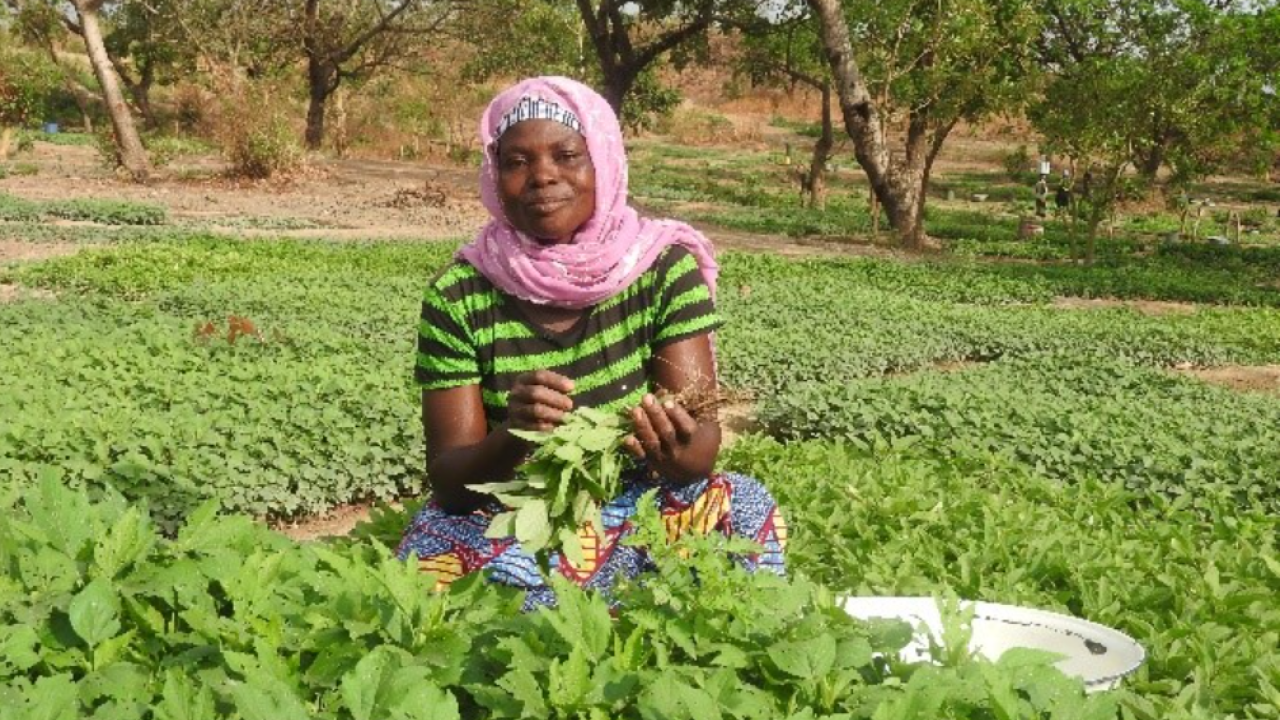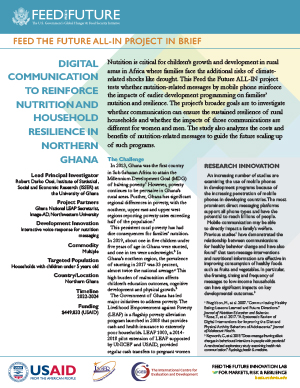
Nutrition is critical for children’s growth and development in rural areas in Africa where families face the additional risks of climate-related shocks like drought. This Feed the Future ALL-IN project tests whether nutrition-related messages by mobile phone reinforce the impacts of earlier development programming on families’ nutrition and resilience. The project’s broader goals are to investigate whether communication can ensure the sustained resilience of rural households and whether the impacts of those communications are different for women and men. The study also analyzes the costs and benefits of nutrition-related messages to guide the future scaling up of such programs.
Project Overview
Lead Principal Investigator: Robert Darko Osei, Institute of Statistical, Social and Economic Research (ISSER) at the University of Ghana
Project Partners: Ghana National LEAP Secretariat, Image-AD, Northwestern University
Development Innovation: Interactive voice response for nutrition messaging
Commodity: Multiple
Targeted Population: Households with children under 5 years old
Country/Location: Northern Ghana
Timeline: 2022-2024
Funding: $591,444 (USAID)
The Challenge
In 2013, Ghana was the first country in Sub-Saharan Africa to attain the Millennium Development Goal (MDG) of halving poverty.[1] However, poverty continues to be pervasive in Ghana’s rural areas. Further, Ghana has significant regional differences in poverty, with the northern, upper east and upper west regions reporting poverty rates exceeding half of the population.[2]
This persistent rural poverty has had dire consequences for families’ nutrition. In 2019, about one in five children under five years of age in Ghana were stunted, and one in ten were underweight.[3] In Ghana’s northern region, the prevalence of stunting in 2017 was 33 percent, almost twice the national average.[4] This high burden of malnutrition affects children’s education outcomes, cognitive development and physical growth.[5]
The Government of Ghana has led major initiatives to address poverty. The Livelihood Empowerment against Poverty (LEAP) is a flagship poverty alleviation program launched in 2008 that provides cash and health insurance to extremely poor households. LEAP 1000, a 2014-2018 pilot extension of LEAP supported by UNICEF and USAID, provided regular cash transfers to pregnant women and mothers with infants under 15 months of age. In addition to supporting consumption, LEAP 1000 sought to reduce stunting and improve the welfare of young children and pregnant women. Importantly, LEAP 1000 participants also participated in an information campaign designed to improve their nutrition.
Direct mobile phone communication through an Interactive Voice Response (IVR) platform may help to expand the nutrition-related impacts of the LEAP 1000 project. While communication on its own will not improve nutrition and reduce poverty, understanding its contributions to these broader efforts can improve its impact in ongoing and future programming.
Research Design

This Feed the Future ALL-IN research project, led by the Institute of Statistical, Social and Economic Research (ISSER) at the University of Ghana, Legon, seeks to understand whether digital communication can reinforce the LEAP 1000 project’s health and nutrition outcomes in Northern Ghana. The project specifically tests whether IVR messages can reinforce the program’s positive impacts.
Participants in the study are households that took part in the LEAP and LEAP 1000 programs who have children under five years old with a primary caregiver and household head who own and use mobile phones. The total number of participants is estimated to be about 1,800 households.
The study design measures the impacts of the IVR messages on LEAP 1000 and LEAP participants separately. For LEAP 1000 participants, the IVR messages may reinforce prior nutrition information. For LEAP participants, the messages may be a means of improving nutrition outcomes.
The team is working with Ghana-based IT firm Image-AD to send out nutrition-based messages by mobile phone to randomly selected households in the treatment groups. The content of the nutrition messages focus on dietary intake and diversity, a clean environment and safe child-feeding practices.
The study measures the impacts of the IVR messaging on household income, household expenditures on water, sanitation and hygiene, spending on food, and dietary diversity as well as children’s nutrition-related outcomes such as weight and height and incidence of illness. The team is also testing whether communication can sustain resilience in terms of nutritional outcomes during the COVID-19 pandemic.
Development Impact
The USAID Country Development Cooperation Strategy (CDCS) has an overall goal of supporting Ghana to increase self-reliance and a healthy and productive life for all citizens. Current inequalities biased against households in Northern Ghana require a systematic approach that takes these inequalities into account. This is particularly important as the adverse effects of the COVID-19 pandemic are likely to linger on and exacerbate spatial inequality.
Programming that strengthens household nutrition could lay the foundation for planning Ghana’s development agenda with poverty and inequality at the heart of such a plan. This ALL-IN project includes an evaluation of the cost effectiveness of using a mobile phone platform to speed up behavior change. Fortunately for Ghana, mobile phone penetration is very high. This makes reducing poverty and improving families’ nutrition by communicating to smallholder farmers with mobile phones a real possibility.
[1] UNDP
[2] Ghana Statistical Service (GSS)
[3] UNICEF
[4] USAID
[5] Osei, R. D. et al. 2021. “Effects of Long-Term Malnutrition on Education Outcomes in Ghana: Evidence from a Panel Study.” The European Journal of Development Research.
This report is made possible by the generous support of the American people through the United States Agency for International Development (USAID) cooperative agreement 7200AA19LE00004. The contents are the responsibility of the Feed the Future Innovation Lab for Markets, Risk and Resilience and do not necessarily reflect the views of USAID or the United States Government.
